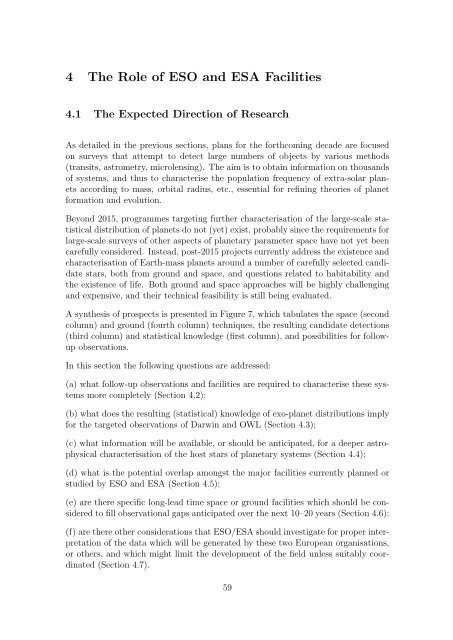Report - School of Physics
Report - School of Physics
Report - School of Physics
You also want an ePaper? Increase the reach of your titles
YUMPU automatically turns print PDFs into web optimized ePapers that Google loves.
4 The Role <strong>of</strong> ESO and ESA Facilities<br />
4.1 The Expected Direction <strong>of</strong> Research<br />
As detailed in the previous sections, plans for the forthcoming decade are focused<br />
on surveys that attempt to detect large numbers <strong>of</strong> objects by various methods<br />
(transits, astrometry, microlensing). The aim is to obtain information on thousands<br />
<strong>of</strong> systems, and thus to characterise the population frequency <strong>of</strong> extra-solar planets<br />
according to mass, orbital radius, etc., essential for refining theories <strong>of</strong> planet<br />
formation and evolution.<br />
Beyond 2015, programmes targeting further characterisation <strong>of</strong> the large-scale statistical<br />
distribution <strong>of</strong> planets do not (yet) exist, probably since the requirements for<br />
large-scale surveys <strong>of</strong> other aspects <strong>of</strong> planetary parameter space have not yet been<br />
carefully considered. Instead, post-2015 projects currently address the existence and<br />
characterisation <strong>of</strong> Earth-mass planets around a number <strong>of</strong> carefully selected candidate<br />
stars, both from ground and space, and questions related to habitability and<br />
the existence <strong>of</strong> life. Both ground and space approaches will be highly challenging<br />
and expensive, and their technical feasibility is still being evaluated.<br />
A synthesis <strong>of</strong> prospects is presented in Figure 7, which tabulates the space (second<br />
column) and ground (fourth column) techniques, the resulting candidate detections<br />
(third column) and statistical knowledge (first column), and possibilities for followup<br />
observations.<br />
In this section the following questions are addressed:<br />
(a) what follow-up observations and facilities are required to characterise these systems<br />
more completely (Section 4.2);<br />
(b) what does the resulting (statistical) knowledge <strong>of</strong> exo-planet distributions imply<br />
for the targeted observations <strong>of</strong> Darwin and OWL (Section 4.3);<br />
(c) what information will be available, or should be anticipated, for a deeper astrophysical<br />
characterisation <strong>of</strong> the host stars <strong>of</strong> planetary systems (Section 4.4);<br />
(d) what is the potential overlap amongst the major facilities currently planned or<br />
studied by ESO and ESA (Section 4.5);<br />
(e) are there specific long-lead time space or ground facilities which should be considered<br />
to fill observational gaps anticipated over the next 10–20 years (Section 4.6);<br />
(f) are there other considerations that ESO/ESA should investigate for proper interpretation<br />
<strong>of</strong> the data which will be generated by these two European organisations,<br />
or others, and which might limit the development <strong>of</strong> the field unless suitably coordinated<br />
(Section 4.7).<br />
59
















